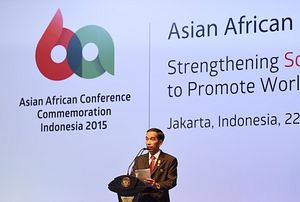The rhetoric coming out of the 60th Commemorative Asian-African Conference that just concluded in Indonesia has grabbed the headlines over the past few days, including calls for a new economic order as well as different visions for growth. “This is [the] revival voice of Asian-African nations that cannot be replaced by anyone,” Indonesian president Joko “Jokowi” Widodo boldly declared before closing the conference, sixty years after the historic Bandung Conference was held in the midst of the Cold War.
But what exactly did the conference achieve? Did the host Indonesia as well as other attending states succeed in reviving cooperation between African and Asian nations as they had intended, and what did the shape of that cooperation look like? The conference proceedings, as well as several documents that were produced, can help us begin to answer these questions. Taken together, they reflect both the general aspirations these states had as well as the specific areas for political, economic and socio-cultural cooperation under the theme of “Strengthening South-South Cooperation to Promote World Peace and Prosperity.”
In terms of general aspirations, on the surface these did include priorities that expressed dissatisfaction with the current world order that made the headlines, including a call for multilateral institutions to be more inclusive and a separate declaration issued on the Palestine issue. But a main objective of the “Declaration on Reinvigorating the New Asian-African Strategic Partnership” – building off of the New Asian-African Strategic Partnership (NAASP) issued a decade ago – was a commitment to a “stronger, more inclusive and sustainable” NAASP. The “inclusive” part of that tagline, the declaration states, encourages the active involvement of development partners and other related stakeholders beyond just the countries of the South, and specifically notes that South-South cooperation is a “complement to, and not a substitute for” North-South development cooperation. While one could dispute how much this rhetoric matches reality, this is nonetheless worth stating because some accounts have only stressed the less inclusive parts of the NAASP.
Moving on to specific areas for cooperation, the attending states seemed to at least be attentive to potential criticism that the conference would yield little in the way of specifics. The Declaration notes that participating states are committed to “implementing ambitious goals and practical initiatives,” and calls on Ministers and officials to take the necessary actions on the eight areas of cooperation recommended at a previous NAASP Senior Officials Meeting in Jakarta in 2009, namely: counterterrorism; combating transnational organized crimes; food security; energy security; small and medium enterprises; tourism; the Asian-African Development University Network; gender equality and women empowerment. Some of these are spelt out in greater detail in later parts of the Declaration.
Other areas are also mentioned that deserve note. These include climate change, infrastructure development, democracy and good governance, and peacekeeping center cooperation, particularly since more than 87% of UN peacekeeping personnel in the field come from Asian-African countries. Some of these proposed areas clearly have Indonesia’s imprint on them, such as the paragraph on the blue economy and maritime-based economy in line with Jokowi’s global maritime axis (which I have written about extensively, including here, here and here) as well as the Indian Ocean in the wake of Jakarta’s chairmanship of the Indian Ocean Rim Association from 2015 to 2017.
Aside from these general aspirations and specific areas of cooperation, there was also attention given to structuring or improving the overall architecture of interactions. Indeed, one section of the Declaration says that the participating states will revitalize the NAASP by “improving its operational framework” through various means. Much of this seems to get at the problem of how to sustain cooperation through the next few years through meetings at various levels in between the Commemorative Asian-African Summits held every ten years. Indonesia also decided to establish an Asian-African Center in Indonesia that would serve as the institutional support base of the NAASP.
Another stride made was the convening of the Asia-Africa Business Summit to strengthen economic ties between these countries, which are actually still far from impressive sixty years after the Bandung Conference. As Jokowi himself admitted at his keynote speech at that summit, even though these countries together account for about 75% of the world’s population and 30% of global GDP, trade and investment had “yet to reflect their true potential.” South African Vice President Cyril Ramaphosa also offered some sobering numbers, with Asia accounting for only 26 percent of trade flow in Africa, and more than three-quarter of that trade coming in the form of oil, gas and metals. This seemed to be a concern for other countries too, as the economic section of the “Bandung Message 2015” document issued itself noted that “Asian-African intra-regional trade and investment has yet to reach its full potential.” While these figures suggest that there is a long way to go before achieving success in this realm, Indonesia and other states deserve credit for attempting to make necessary improvements.
It is still too early to tell whether the various pledges adopted at this conference will be carried out effectively and what that will mean for the state of the NAASP. But despite the limitations often cited with respect to this large and diverse gathering – such as the tendency for vague declarations, a significant number of no-shows, as well as the commitment made to human rights in spite of the inclusion of dictatorships like Zimbabwe – participating states as well as Indonesia as the host nation seemed cognizant about these challenges and sincere about addressing some of them to the extent possible. In that sense, even if some might argue Jakarta and others did not ‘revive’ or ‘reinvigorate’ the NAASP to the extent that they could have, they have at least tried to institute a few reforms and set out some specific priorities to improve how they advance their strategic partnership in the coming years.

































